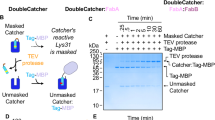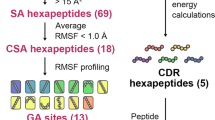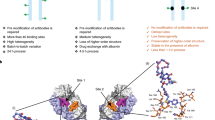Abstract
The ribonuclease barnase (12 kDa) and its inhibitor barstar (10 kDa) form a very tight complex in which all N and C termini are accessible for fusion. Here we exploit this system to create modular targeting molecules based on antibody scFv fragment fusions to barnase, to two barnase molecules in series and to barstar. We describe the construction, production and purification of defined dimeric and trimeric complexes. Immobilized barnase fusions are used to capture barstar fusions from crude extracts to yield homogeneous, heterodimeric fusion proteins. These proteins are stable, soluble and resistant to proteolysis. Using fusions with anti-p185HER2-ECD 4D5 scFv, we show that the anticipated gain in avidity from monomer to dimer to trimer is obtained and that favorable tumor targeting properties are achieved. Many permutations of engineered multispecific fusion proteins become accessible with this technology of quasi-covalent heterodimers.
This is a preview of subscription content, access via your institution
Access options
Subscribe to this journal
Receive 12 print issues and online access
$209.00 per year
only $17.42 per issue
Buy this article
- Purchase on Springer Link
- Instant access to full article PDF
Prices may be subject to local taxes which are calculated during checkout




Similar content being viewed by others
References
Batra, S.K., Jain, M., Wittel, U.A., Chauhan, S.C. & Colcher, D. Pharmacokinetics and biodistribution of genetically engineered antibodies. Curr. Opin. Biotechnol. 13, 603–608 (2002).
Plückthun, A. & Pack, P. New protein engineering approaches to multivalent and bispecific antibody fragments. Immunotechnol. 3, 83–105 (1997).
Todorovska, A. et al. Design and application of diabodies, triabodies and tetrabodies for cancer targeting. J. Immunol. Methods 248, 47–66 (2001).
Bennett, M.J., Schlunegger, M.P. & Eisenberg, D. 3D domain swapping: a mechanism for oligomer assembly. Prot. Sci. 4, 2455–2468 (1995).
Dreier, T. et al. Extremely potent, rapid and costimulation-independent cytotoxic T-cell response against lymphoma cells catalyzed by a single-chain bispecific antibody. Int. J. Cancer 100, 690–697 (2002).
Rodrigues, M.L. et al. Engineering Fab' fragments for efficient F(ab)2 formation in Escherichia coli and for improved in vivo stability. J. Immunol. 151, 6954–6961 (1993).
King, D.J. et al. Improved tumor targeting with chemically cross-linked recombinant antibody fragments. Cancer Res. 54, 6176–6185 (1994).
Hill, C.P., Anderson, D.H., Wesson, L., DeGrado, W.F. & Eisenberg, D. Crystal structure of alpha 1: implications for protein design. Science 249, 543–546 (1990).
O'Shea, E.K., Klemm, J.D., Kim, P.S. & Alber, T. X-ray structure of the GCN4 leucine zipper, a two-stranded, parallel coiled coil. Science 254, 543–544 (1991).
Jeffrey, P.D., Gorina, S. & Pavletich, N.P. Crystal structure of the tetramerization domain of the p53 tumor suppressor at 1.7 angstroms. Science 267, 1498–1502 (1995).
Pack, P. & Plückthun, A. Miniantibodies: use of amphipathic helices to produce functional, flexibly linked dimeric Fv fragments with high avidity in Escherichia coli. Biochemistry 31, 1579–1584 (1992).
de Kruif, J. & Logtenberg, T. Leucine zipper dimerized bivalent and bispecific scFv antibodies from a semi-synthetic antibody phage display library. J. Biol. Chem. 271, 7630–7634 (1996).
Terskikh, A.V. et al. “Peptabody”: a new type of high avidity binding protein. Proc. Natl. Acad. Sci. USA 94, 1663–1668 (1997).
Yazaki, P.J. & Wu, A.M. Construction and characterization of minibodies for imaging and therapy of colorectal carcinomas. Meth. Mol. Biol. 207, 351–364 (2003).
Carter, P. Bispecific human IgG by design. J. Immunol. Methods 248, 7–15 (2001).
Hartley, R.W. Barnase-barstar interaction. Methods Enzymol. 341, 599–611 (2001).
Schreiber, G. Methods for studying the interaction of barnase with its inhibitor barstar. Methods Mol. Biol. 160, 213–226 (2001).
Schreiber, G. & Fersht, A.R. Rapid, electrostatically assisted association of proteins. Nat. Struct. Biol. 3, 427–431 (1996).
Green, N.M. Avidin and streptavidin. Methods Enzymol. 184, 51–67 (1990).
Guillet, V., Lapthorn, A., Hartley, R.W. & Mauguen, Y. Recognition between a bacterial ribonuclease, barnase, and its natural inhibitor, barstar. Structure 1, 165–177 (1993).
Buckle, A.M., Schreiber, G. & Fersht, A.R. Protein-protein recognition: crystal structural analysis of a barnase-barstar complex at 2.0-A resolution. Biochemistry 33, 8878–89 (1994).
Eigenbrot, C., Randal, M., Presta, L., Carter, P. & Kossiakoff, A.A. X-ray crystal structures of the antigen-binding domains from three variants of humanized anti-p185HER2 antibody 4D5 and comparison with molecular modeling. J. Mol. Biol. 229, 969–995 (1993).
Willuda, J. et al. Tumor targeting of mono-, di-, and tetravalent anti-p185(HER-2) miniantibodies multimerized by self-associating peptides. J. Biol. Chem. 276, 14385–14392 (2001).
Slamon, D. et al. Studies of the HER-2/neu proto-oncogene in human breast and ovarian cancer. Science 244, 707–712 (1989).
Yarden, Y. & Sliwkowski, M.X. Untangling the ErbB signalling network. Nat. Rev. Mol. Cell Biol. 2, 127–137 (2001).
Waibel, R. et al. Stable one-step technetium-99m labeling of His-tagged recombinant proteins with a novel Tc(I)-carbonyl complex. Nat. Biotechnol. 17, 897–901 (1999).
Deyev, S.M., Yazynin, S.A., Kuznetsov, D.A., Jukovich, M. & Hartley, R.W. Ribonuclease-charged vector for facile direct cloning with positive selection. Mol. Gen. Genet. 259, 379–382 (1998).
Hartley, R.W. Barnase and barstar. Expression of its cloned inhibitor permits expression of a cloned ribonuclease. J. Mol. Biol. 202, 913–915 (1988).
Hartley, R.W. Barnase and barstar: two small proteins to fold and fit together. Trends Biochem. Sci. 14, 450–454 (1989).
Wörn, A. & Plückthun, A. Stability engineering of antibody single-chain Fv fragments. J. Mol. Biol. 305, 989–1010 (2001).
Wörn, A. & Plückthun, A. An intrinsically stable antibody scFv fragment can tolerate the loss of both disulfide bonds and fold correctly. FEBS Lett. 427, 357–361 (1998).
Lindner, P. et al. Specific detection of his-tagged proteins with recombinant anti-His tag scFv-phosphatase or scFv-phage fusions. Biotechniques 22, 140–149 (1997).
Yazaki, P.J. et al. Tumor targeting of radiometal labeled anti-CEA recombinant T84.66 diabody and T84.66 minibody: Comparison to radioiodinated fragments. Bioconjugate Chem. 12, 220–228 (2001).
Nielsen, U.B., Adams, G.P., Weiner, L.M. & Marks, J.D. Targeting of bivalent anti-ErbB2 antibody fragments to tumor cells is independent of the intrinsic antibody affinity. Cancer Res. 60, 6434–6440 (2000).
Casey, J.L. et al. Dosimetric evaluation and radioimmunotherapy of anti-tumour multivalent Fab' fragments. Br. J. Cancer 81, 972–980 (1999).
Tahtis, K. et al. Biodistribution properties of (111)indium-labeled C-functionalized trans-cyclohexyl diethylenetriaminepentaacetic acid humanized 3S193 diabody and F(ab′)(2) constructs in a breast carcinoma xenograft model. Clin. Cancer Res. 7, 1061–1072 (2001).
Trejtnar, F. & Laznicek, M. Analysis of renal handling of radiopharmaceuticals. Q. J. Nucl. Med. 46, 181–194 (2002).
Ge, L., Knappik, A., Pack, P., Freund, C. & Plückthun, A. Expressing antibodies in Escherichia coli. in Antibody Engineering, edn.2 (ed. Borrebaeck, C.A.K.) 229–266 (Oxford University Press, Oxford, 1995).
Knappik, A. & Plückthun, A. Engineered turns of a recombinant antibody improve its in vivo folding. Protein Eng. 8, 81–89 (1995).
Hartley, R.W. Directed mutagenesis and barnase-barstar recognition. Biochemistry 32, 5978–5984 (1993).
Bass, S., Gu, Q. & Christen, A. Multicopy suppressors of prc mutant Escherichia coli include two HtrA (DegP) protease homologs (HhoAB), DksA, and a truncated R1pA. J. Bacteriol. 178, 1154–1161 (1996).
Miller, K. et al. Design, construction, and in vitro analyses of multivalent antibodies. J. Immunol. 170, 4854–4861 (2003).
Acknowledgements
The authors thank Jörg Willuda for discussions during the initial phase of this project, Annemarie Honegger for molecular modeling, Stephen F. Marino for help and comments, and Frank Bootz and Lydie Chané-Favre for help in the immunogenicity experiments. The work was supported by grants from, among others, the Swiss National Science Foundation (no. 7UPJ062274), the Russian Foundation of Basic Research (no. 01-04-49450) and the Russian Science Support Foundation (no. 2077.2003.4) and PCB RAS.
Author information
Authors and Affiliations
Corresponding authors
Ethics declarations
Competing interests
The authors declare no competing financial interests.
Supplementary information
Rights and permissions
About this article
Cite this article
Deyev, S., Waibel, R., Lebedenko, E. et al. Design of multivalent complexes using the barnase·barstar module. Nat Biotechnol 21, 1486–1492 (2003). https://doi.org/10.1038/nbt916
Received:
Accepted:
Published:
Issue Date:
DOI: https://doi.org/10.1038/nbt916
This article is cited by
-
Real-time measurement of protein–protein interactions at single-molecule resolution using a biological nanopore
Nature Biotechnology (2019)
-
Nuclear nanomedicine using Si nanoparticles as safe and effective carriers of 188Re radionuclide for cancer therapy
Scientific Reports (2019)
-
CID fragmentation, H/D exchange and supermetallization of Barnase-Barstar complex
Scientific Reports (2017)
-
Efficient production of single-chain fragment variable-based N-terminal trimerbodies in Pichia pastoris
Microbial Cell Factories (2014)
-
Optimising the radiolabelling properties of technetium tricarbonyl and His-tagged proteins
EJNMMI Research (2014)



